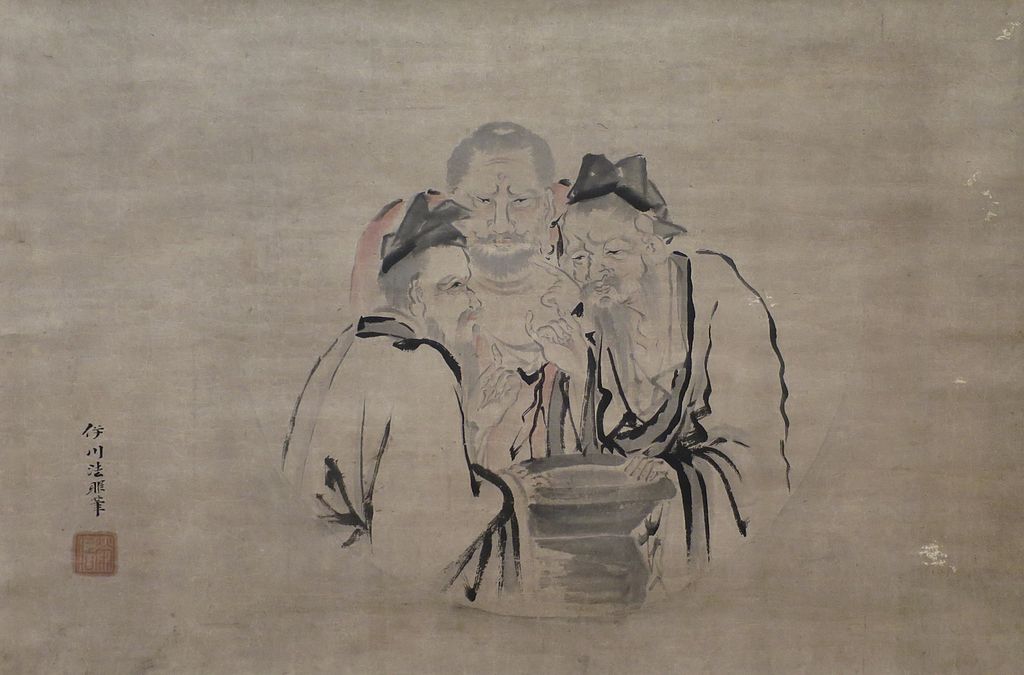Chinese Vegan Guide to Black Vinegar
You may have seen some Chinese recipes that call for black vinegar and wondered whether it’s the same as something like a Balsamic or white wine vinegar, which is more commonly used in Western cooking. The answer is yes and no. To be simplistic, vinegar is made by process of fermenting wine (already a fermented product). So while Balsamic or wine vinegars are made from grape wine, Chinese vinegar tends to be made from rice wine, and sometimes from other grains such as barley or millet.
Indeed, China was the first country to make vinegar from grain, with the first written recordings of vinegar tracing back to 8th century BC. An old Chinese saying indicates just how vital vinegar was to both diet and culture:
Firewood, rice, oil, salt, sauce, vinegar and tea are indispensable in our daily life.
One of my favourite manifestations of vinegar in Chinese cultural history is the Vinegar Tasters, a common subject of religious painting that allegorises the three main philosophical and religious teachings of China. A summary from The Tao of Pooh can be found at taoism.net.
Zhenjiang or Chinkiang vinegar is the most well–known vinegar within and outside of China — and the ideal all–purpose Chinese vinegar with which to stock your cupboard. Produced in the eponymous Zhenjiang region on the eastern coast of China, its main ingredient is fermented glutinous rice, sometimes along with wheat and other grains. Its distinctive black colour comes from aging, with a flavour that is both sweet and sour. It’s not as sweet as Balsamic vinegar, and is distinctly smoky, woody and tart.
The other Chinese vinegar you may have come across is red rice vinegar, especially as it often accompanies certain types of dumplings. This vinegar is fermented from red yeast rice, also a common Chinese dietary supplement.
Benefits
While drinking apple cider vinegar has become a bit of a trend in recent years, black vinegar has been promoted as a health tonic in China since 300BC. You can choose to take this advice with a pinch of … vinegar.
High in citric acids, may boost digestion and metabolism
High in antioxidants
High in essential amino acids
Alkalizing, may help to regulate body’s pH
Tips
Rice vinegar is best used at the end rather than at the beginning of cooking, unless you are cooking something like a vinegar–based braise.
Since it is acidic, use a small dash to ‘lift’ a dish, or to correct an imbalance in other flavours (i.e. if it’s too sweet, salty, bitter or spicy).
Black vinegar and soy sauce are good friends; a simple half and half combination makes a tasty dipping sauce for dumplings.
If a recipe calls for a lighter rice vinegar, you can find an easy substitute in commonly found Japanese brands.
Healthy vegan recipes
Smashed cucumber salad (chinasichuanfood.com)
Rice vinegar healty tonic (thehongkongcookery.com)
Hot and sour soup — omit the egg to make it vegan (tastehongkong.com)
Five-minute Zhenjiang noodles (messyvegancook.com)
My own recipe for cold steamed silken aubergine
Further reading
Trekking to Kirishima Japan to learn about kurozu, Japanese aged black vinegar (saveur.com)
A concise cultural history of vinegar in China (supremevinegar.com)








